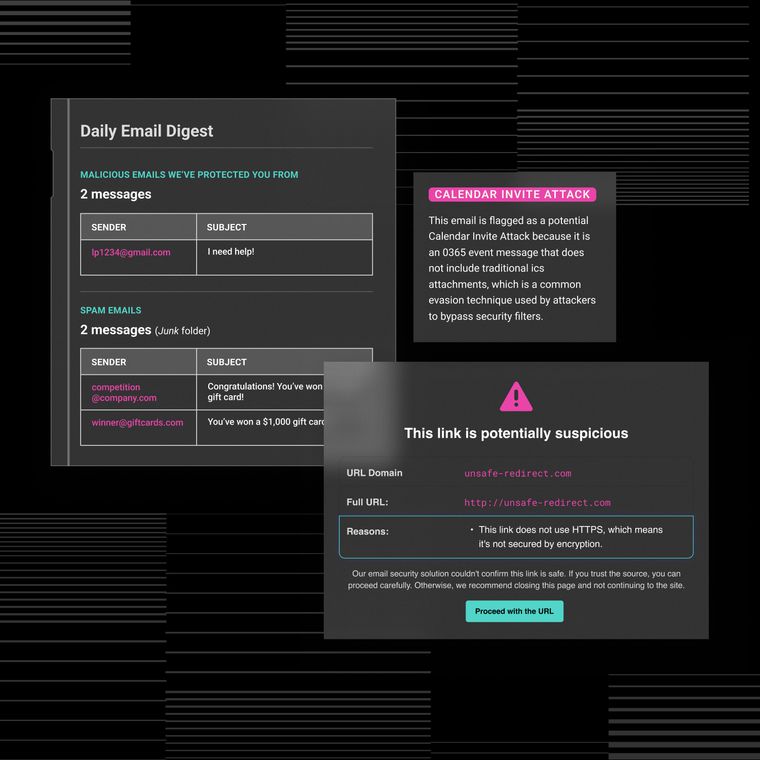Securing Educational Email Systems: Best Practices for Higher Education Institutions
Higher education faces rising cyber threats. Learn how to protect your school from advanced attacks.
July 2, 2025
Universities sit at the intersection of open access and high-value data. They manage massive volumes of personal information, research IP, financial records, and healthcare data, while operating in environments designed for collaboration, decentralization, and academic freedom. That combination makes them a prime target for ransomware, credential theft, and business email compromise (BEC).
In this article, we’ll break down the unique cybersecurity challenges facing higher education, common threat tactics, and how modern defenses—especially behavior-based detection—can help secure even the most open environments.
The Cyber Threat Landscape in Higher Education
Universities operate with large, open networks and support thousands of users, vendors, and systems, all moving at the pace of modern education. Institutions manage sensitive student records, research data, grant funding, and health information across fragmented infrastructure and decentralized IT environments.
This complexity creates a wide attack surface. Many institutions support outdated systems, lack full visibility into user behavior, and depend on third-party platforms that fall outside of direct control. Cybercriminals target these gaps to steal credentials, disrupt operations, or gain access to financial workflows.
Common threats include:
Ransomware That Disrupts Learning and Research: Attackers lock systems and demand large payouts, often delaying instruction and grant-funded work.
Credential Harvesting Across User Populations: Phishing and impersonation campaigns target students, staff, and faculty to gain account access.
BEC Targeting Financial and Administrative Workflows: Fraudulent emails redirect tuition payments, vendor invoices, and payroll disbursements.
Advanced Malware That Evades Traditional Defenses: AI-generated payloads bypass legacy filters and maintain persistent access to internal systems.
Data Breaches From Weak Identity Controls: Compromised credentials and outdated authentication methods lead to large-scale data exposure.
Exploitation of Legacy Infrastructure: Unpatched systems still in use by research labs or administrative offices expose critical services.
Third-Party Supply Chain Risk: Vulnerabilities in SaaS platforms, edtech tools, or vendor systems allow attackers to pivot into institutional networks.
DDoS Attacks That Disrupt Campus Operations: Targeted traffic floods disable portals, learning platforms, and registration systems during critical periods.
These threats often go undetected until real damage has occurred, whether that means stolen research, delayed operations, or funds permanently lost. Large user populations and inconsistent enforcement make threat detection especially difficult across departments, campuses, and tools.
To reduce risk, higher education institutions need visibility into behavioral patterns that span users, systems, and third-party communications. Proactive monitoring, adaptive controls, and email security that understands context are critical for identifying threats early and stopping attackers before they gain traction.
Why Traditional Security Tools Struggle in Higher Ed
Most higher education environments were never built with centralized security in mind. Universities support open collaboration, decentralized decision-making, and a diverse mix of users and technologies. These conditions make traditional security controls hard to implement and even harder to enforce.
Legacy tools that rely on network perimeter control, static policies, or rigid endpoint management often fall short. These systems can’t adapt to the constant churn of users, devices, and departments or to the wide variety of applications and access needs that define a modern university.
Common limitations include:
Decentralized IT and Inconsistent Policy Enforcement: Department-level autonomy leads to fragmented controls, tools, and risk tolerance.
Outdated Systems That Can’t Be Patched or Replaced: Research labs and administrative offices often rely on unsupported infrastructure.
Open Networks That Invite Broad Access: Many institutions prioritize ease of access over strict segmentation or access controls.
Diverse User Populations With Varying Awareness: Students, faculty, vendors, and contractors introduce unpredictable behavior and risk.
Limited Visibility Across Systems and Communication Channels: Security teams often lack centralized insight into email, identity, and app behavior.
These limitations create gaps in visibility that attackers exploit, whether through compromised credentials, internal impersonation, or lateral movement across under-monitored systems. Effective security in higher education requires solutions that can operate across silos, adapt to behavior, and reduce the burden on already-stretched IT and security teams.
Effective Cybersecurity Tips for Higher Education
Higher education environments are complex. Open networks, diverse users, and constant device turnover expand the potential attack surface. Security teams often manage high-risk systems, such as email, cloud apps, and research databases, with limited headcount and resources.
A strong strategy focuses on reducing workload while improving visibility. That means using behavioral intelligence to flag abnormal activity, securing every layer of email communication, and giving end users the tools to act on threats. When security works quietly in the background and users understand their role, institutions gain protection that scales with their needs.
1. Detect Threats Through Behavior, Not Just Rules
Static rule sets can’t keep up with the pace or complexity of today’s attacks in higher education. Socially engineered threats, like BEC or account takeover (ATO), often look perfectly legitimate to traditional tools. They slip through because they don’t match known signatures or threat patterns.
Security teams should prioritize solutions that analyze behavioral baselines. That means detecting when a department head suddenly requests financial transfers, or when login behavior changes location, timing, or device profile. These subtle anomalies signal risk long before damage is done.
To put this into practice:
Audit your existing detection tools to understand where they rely on static rules versus adaptive modeling.
Implement behavioral anomaly detection that learns communication patterns across students, faculty, staff, and third-party vendors.
Integrate detection with response so that flagged anomalies can trigger automated investigation or quarantine before reaching the inbox.
Abnormal’s behavioral AI platform brings this to life across Microsoft 365 and Google Workspace environments, learning the legitimate behavior of every user and communication stream to stop threats others miss.
2. Secure the Entire Email Ecosystem
Email is usually the primary vector for credential phishing, invoice fraud, and impersonation attacks across higher education. From student records and financial aid details to research grants and vendor invoices, email touches every critical system.
Protecting the full ecosystem means going beyond basic filtering. You need visibility into how people and departments communicate, especially across external partners, cloud platforms, and legacy systems.
To strengthen email security across campus:
Deploy email security that analyzes message context, not just links and attachments. Attacks often appear clean but contain behavioral red flags.
Monitor email traffic across departments, including HR, finance, admissions, and IT. Each handles high-value data and is frequently impersonated.
Automate remediation of suspicious messages by removing them post-delivery, not just pre-filtering.
Abnormal does this by understanding every user, detecting deviations, and stopping malicious messages in real time, even those that appear internally sourced or free of payloads. This protects not just inboxes, but institutional integrity.
3. Protect Against Vendor and Supply Chain Risk
Higher education institutions rely on a wide network of third-party vendors, from cloud providers and grant partners to facilities contractors and outsourced services. These relationships often involve sensitive communications and financial transactions, making them a prime target for cybercriminals. When attackers compromise a vendor account or spoof a supplier domain, they gain a trusted pathway into the university’s ecosystem.
The key to defense is early detection. Security teams should monitor for behavioral anomalies in vendor communications, like changes in payment instructions, shifts in tone or timing, or unexpected attachments. Strong email authentication helps prevent spoofing, but it’s not enough to catch compromised accounts still sending from legitimate infrastructure.
Solutions like Abnormal’s VendorBase enhance this visibility by identifying trusted suppliers and detecting unusual behavior over time, helping institutions catch threats that would otherwise blend in.
4. Train the Entire Campus
In higher education, security training can’t stop at IT or administrative staff. Faculty, researchers, and students all handle sensitive data and access critical systems. That makes them equally important in your cybersecurity strategy—and equally likely to be targeted.
Effective awareness programs need to go beyond one-off trainings. Use role-specific content that reflects real threats each group faces, from phishing emails to fake financial aid portals. Incorporate scenario-based modules and ongoing phishing simulations that adapt to emerging tactics.
Abnormal’s AI Phishing Coach supports this approach with just-in-time training triggered by user behavior. Instead of static videos or forgotten LMS courses, users receive relevant coaching when it matters most—during actual interactions with suspicious content.
Make reporting suspicious emails easy and reward participation. When the entire campus community sees themselves as part of the defense, your security posture improves across the board.
5. Reduce Load on Overburdened IT Teams
IT teams in higher education often operate with limited staff and shrinking budgets, even as cyber threats grow more complex. Managing dozens of disconnected security tools, triaging false positives, and responding to incidents leaves little room for proactive defense.
To reduce the burden, focus on technologies that integrate easily with your existing cloud environments like Microsoft 365 and Google Workspace. Prioritize platforms that provide real-time insights, automate low-level tasks, and consolidate alerts based on threat severity rather than triggering on every anomaly.
Abnormal’s behavioral AI lightens the load by automatically flagging only the most relevant risks, filtering out noise, and minimizing manual intervention. With fewer alerts to chase and a clearer picture of true threats, campus security teams can focus their time where it counts: preventing attacks, not reacting to them.
Securing What Matters Most in Higher Education
In higher education, security isn’t just about stopping threats. It’s about protecting the trust that fuels discovery, collaboration, and learning. As cyberattacks grow more advanced, so must the defenses that safeguard your institution.
Abnormal’s behavioral AI delivers the visibility and precision colleges and universities need to stay ahead of phishing, impersonation, and account compromise. It’s security that understands your environment and adapts with it.
Learn how Abnormal can strengthen your institution’s security posture by booking a demo today.
Related Posts
Get the Latest Email Security Insights
Subscribe to our newsletter to receive updates on the latest attacks and new trends in the email threat landscape.


